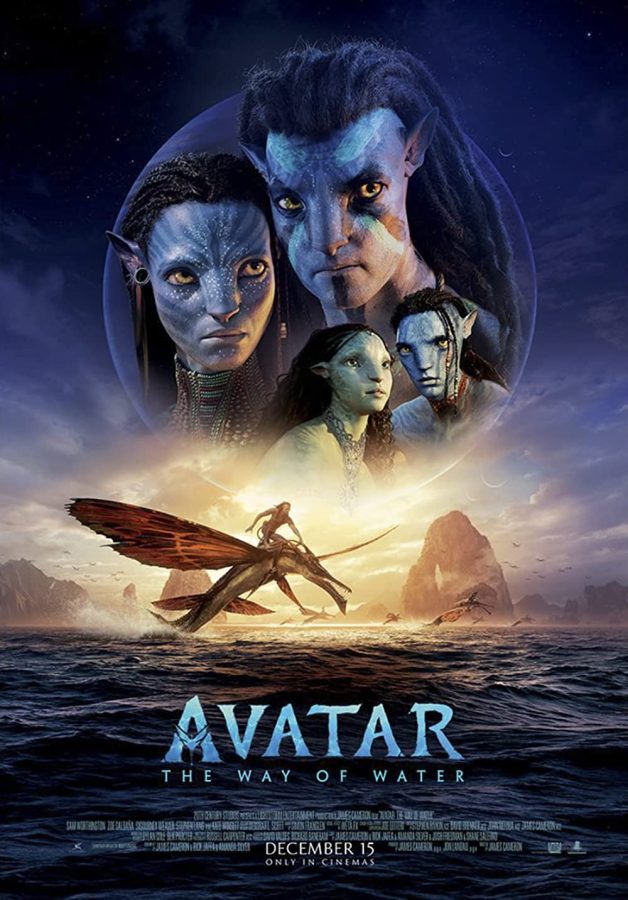“Avatar: The Way of Water” Sees Visual and Narrative Glow-Up From Predecessor
Avatar: The Way of Water came around at a time when water — well, ice, but I digress — was certainly having its way with us.
Avatar premiered on December 18, 2009. Long the highest-grossing movie of all time, the movie came and went in the public mind. Thus it became a surprise that 13 years after the first burst into theaters, threw everything into disarray, and left for an indeterminate amount of time, “Avatar 2” would finally release the painstaking passion project of professional blockbuster-creator James Cameron.
I watched the first at home, and like almost everyone, I thought it was alright. The visuals were striking, the world painfully impressive, the production intense, and the action serviceable. However, the narration was grating, the plot generic at best and white savior-ish at worst, the characters largely forgettable, and the music distractingly European — for reasons that can and have taken up entire dissertations.
Thus, the only reasons I decided to see the sequel were, admittedly, the hype and the fact that I’d not been to a theater for an embarrassingly long time. I will say I had a great time with my reintroduction to big-theater film.
Somehow James Cameron has created a product with even more impressive visual effects than its predecessor. Avatar, despite its age, remains incredible even compared to modern movies. Its sequel blows it out of the water, figuratively and literally.
I can try to describe how the water simulations are perfect, how you can see individual peach-fuzz hairs in close-ups, and how light permeates skin in a noticeable but subtle way. I can try to convey how convincing the world is, such that I had to actively think to figure out where CGI started and live action ended, a testament to both the visual effects and impressive set design, prop choice, and artistic direction. But it’s a fruitless venture to convey through text, perhaps only truly accessible through the portal of the silver screen and optimally on the wide-screen immersion of an IMAX theater.
However, I think the visual effects themselves — though so inventive they’ve already changed the industry forever — pale in comparison to the way they’re used: the world remains so detailed and thought-out, taking the incredible setting of Pandora set up in the first Avatar and expanding it. People talked about how the world of Pandora felt real in the first Avatar, but the second amps it up by introducing the visual eye candy of the reef villages and their sheer underwater diversity.
The incredible diversity of creatures and plants, all in the fully considered ecosystem of Avatar, translates perfectly to the wonder of reefs and sandy islands. While the first Avatar felt a bit overindulgent in the scope of its many nature scenes, The Way of Water feels much more manageable, and the movie races despite being almost half an hour longer.
The action also saw a massive glow-up, particularly hand-to-hand combat that I’m sure was scarce in the first movie thanks to technical limitations. The action is on a new level, making it distinct from the first movie and continually enticing to watch, even when a single set piece lasts half an hour.
Everybody talks about visuals, forgetting the meager plot of the first Avatar. Surprisingly, I’d say the story and characters of the second movie are a vast improvement to the first, to the point that the first movie feels like a pilot episode to a TV show in comparison.
The plot still isn’t stellar but is overall more intriguing. The movie follows Jake Sully and Ney’tiri as they fight to protect their newly formed family and home, driving them to leave the Omaticaya and find refuge with the Metkayina reef people. Already the premise is more interesting than the original, but it is aided by the cast seeing greater depth beyond “the protagonist,” “the scientist,” “the bad guy capitalist,” “the Marine,” and “the native lady.”
Jake and Neytiri’s children get good characterization and have good dynamics, like the younger brother Lo’ak having to cope with being a disappointment to his family and Kiri finding a spiritual bond with the sea. Jake himself gets a more interesting — though still generic — subplot about learning to take care of his children while being a wartime general. Spider is fascinating as a human raised in a largely Na’vi environment, and we begin seeing his internal conflict as he finds himself used in the battle between humans and Na’vi. Quaritch, returned in Avatar form, finally gets greater complexity than just being a generic army guy, and I’m genuinely intrigued by the parallels we see between him, a human in a Na’vi body, his biological human son Spider raised in a Na’vi environment, and Jake.
The movie feels unconcluded — most of the characters, new as they are, only have their foundations set, no buildings yet. I suppose that’s the point, though. If the first Avatar is a TV show pilot, The Way of Water is the first of a several-part special, enticing audiences to come back. With its incredible visuals, infinitely more interesting characters, and promise of even greater horizons, it has undoubtedly succeeded in hooking me.
You can take the woman out of the bird, but you can't take the bird out of the woman: meet Yoon Lee.

